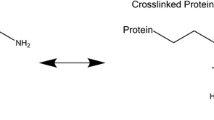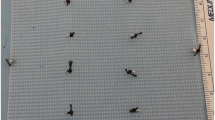Abstract
The repair of incisional hernias has taken advantage of the strength provided by prosthetic mesh grafts, but the best position for inserting the materials has not been conclusively established. Environmental scanning electron microscopy (ESEM) provides imaging of bio-logic samples with minimal manipulation. We used ESEM for early imaging of the integration response to polypropylene meshes placed in two anatomic positions in the abdominal wall and correlated results with tensiometric studies. Two macroporous polypropylene prostheses were implanted in a rat model—one on the abdominal aponeurotic layer and one on the peritoneal surface—without creating a wall defect. Studies were performed over implantation intervals of 7, 15, and 30 days in strips obtained from the polypropylene fiber-receptor repair tissue interface. Microscopic appearance, tensile strength, percent elongation, and stiffness were evaluated. Meshes implanted on the abdominal aponeurotic layer showed better early tissue incorporation (higher collagen deposition, capillary density, cell accumulation) and increased tensile strength, reflecting tighter anchorage to the abdominal wall. The percent elongation increased from day 7 to day 30 after implantation, mainly in the deep stratum. The ESEM images correlated well with biomechanical results, indicating the potential of this technique as a powerful, effective tool for use in wound-healing studies.
Résumé
La cure des éventrations est basée sur la robuste d’une prothèse mais le meilleur endroit pour positionner cette prothèse n’est pas établi. La microscopie électronique peut fournir des images d’ordre biologique nécessitant un minimum de manipulations. Nous avons utilisé la ME pour mettre en évidence la réponse précoce de l’intégration aux prothèses de polypropylene, placées en deux positions anatomiques difféentes de la paroi abdominale et ensuite, nous avons corrélé ces résultats avec des études tensiométriques. On a donc implanté, chez le rat, deux prothèses de polypropylene macroporeuses, une sur l’aponévrose et l’autre sur la surface du péritoine, sans créer de defect pariétal. Des bandes provenant de l’interface de réparation tissu receveur/polypropylene ont été étudiées 7, 15 et 30 jours après l’implantation. L’aspect microscopique, la résistance à la rupture, le degré d’élongation et la rigidité ont été évalués. L’incorporation des prothèses, l’accumulation cellulaire et la résistance à la rupture étaient meilleures lorsque la prothèse avait été implantée sur l’aponévrose, témoignant d’un ancrage plus serré à la paroi abdominale. L’élongation avait eu lieu entre jours 7 à 30, surtout dans la couche profonde. L’imagerie ME corrélait bien avec les résultats biomécaniques, suggérant que cette technique était potentiellement un outil efficace et puissant pour la réparation.
Resumen
Gracias a la introducción de mallas protésicas en el tratamiento de las eventraciones postoperatorias, se han mejorado espectacularmente los resultados operatorios; sin embargo, sigue estando controvertido el lugar donde dichas mallas han de colocarse. La escanografia del entorno con microscopio electrónico (ESEM) permite obtener imágenes de muestras biológicas con una minima manipulación. Hemos empleado el ESEM con objeto de averiguar la capacidad de integración de las mallas de polipropileno colocadas en dos planos diferentes de la pared abdominad, correlacionando los resultados con estudios tensiométricos. Utilizando ratas, implantamos prótesis macroporosas de polipropileno en el plano aponeurótico y sobre el plano peritoneal del abdomen, sin efectuar solución de continuidad alguna de la pared abdominal. A los 7, 15 y 30 días tras la implantación se obtuvieron tiras de la malla de polipropileno para averiguar el acoplamiento que se produce entre el plano anatómico y la prótesis. Se evaluaron: el aspecto microscópico, la fuerza tensil, el porcentaje de elongación y rigidez. Las mallas implantadas en el plano aponeurótico abdominal mostraron una incorporación mejor y más rápida a los tejidos; se produjo una mayor acumulación celular con una mayor fuerza tensil, lo que demuestra un intimo anclaje a la pared abdominal. El porcentaje de elongación se incrementó desde el 7 al 30 días postimplante, sobre todo cuando la malla se colocó en planos profundos: preperitoneales. Las imágenes del ESEM se correlacionan perfectamente con los resultados biomecánicos, demostrando que esta técnica es adecuada y efectiva para estudios sobre la cicatrización de las heridas.
Similar content being viewed by others
References
DeBord, J.R.: The historical development of prosthetics in hernia surgery. Surg. Clin. North Am. 75:973, 1998
Usher, F.C.: New technique for repairing incisional hernias with Marlex mesh. Am. J. Surg. 138:140, 1979
Stoppa, R.E.: The treatment of complicated groin and incisional hernias. World J. Surg. 13:545, 1989
Matapurkar, B.G., Gupta, A.K., Agarwal, A.K.: A new technique of “Marlexperitoneal sandwich” in the repair of large incisional hernias. World J. Surg. 25:768, 1991
Molloy, R.G., Moran, K.T., Waldron, R.P., Brady, M.P., Kirwan, W.O.: Massive incisional hernia: abdominal wall replacement with Marlex mesh. Br. J. Surg. 75:242, 1991
Vidal, J., Fernández-Llamazares, J.: Myoplastie abdominale totale et partielle pour le soin radical des éventrations. In Proceedings of the 66e Congrès de FAssociation des Anatomistes, Barcelona, Espaxs, 1983, p. 146
Dabrowiecki, S., Svanes, K., Lekven, J., Grong, K.: Tissue reaction to polypropylene mesh: a study of oedema, blood flow, and inflammation in the abdominal wall. Eur. Surg. Res. 23:240, 1991
Danilatos, G.D.: Introduction to the ESEM instrument. Microsc. Res. Tech. 25:354, 1993
Arbós, M.A., Ferrando, J.M., Segarra, A., Vidal, J., Huguet, P., Armengol, M., Schwartz, S.: The effects of arginine administration on the amino acid levels and the acute cellular inflammatory response: experimental study after the implantation of prosthetic material in the rat abdominal wall. Amino Acids 17:117, 1999
Statgraphics. Reference Manual, Version 6.0. Manugistics, Rockville, MD, USA, 1992, pp. M9-M25
DeBord, J.R.: The rationale for the selection of a prosthetic biomaterial in hernia repair. Probl. Gen. Surg. 12:75, 1995
Bellón, J.M., Bujá, J., Contreras, L., Hernando, A.: Integration of biomaterials implanted into abdominal wall: process of scar formation and macrophage response. Biomaterials 16:381, 1995
Bellón, J.M., Buján, J., Contreras, LA., Carreras-San Martin, A., Hernando, A., Jurado, F.: Improvement of the tissue integration of a new modified polytetrafluorethylene prosthesis: Mycro Mesh®. Biomaterials 17:1265, 1996
Bellón, J.M., Buján, J., Contreras, L., Hernando, A.: Interface formed between visceral peritoneum and experimental polypropylene or poly-tetrafluoroethylene abdominal wall implants. J. Biomater. Sei. Mater. Med. 7:331, 1996
Klinge, U., Klosterhalfen, B., Conze, J., Limberg, W., Obolenski, B., Öttinger, A.P., Schumpelick, V.: Modified mesh for hernia repair that is adapted to the physiology of the abdominal wall. Eur. J. Surg. 164:951, 1988
Author information
Authors and Affiliations
Corresponding author
Rights and permissions
About this article
Cite this article
Ferrando, J.M., Vidal, J., Armengol, M. et al. Early imaging of integration response to polypropylene mesh in abdominal Wall by environmental scanning electron microscopy: Comparison of two placement techniques and correlation with tensiometric studies. World J. Surg. 25, 840–847 (2001). https://doi.org/10.1007/s00268-001-0038-z
Issue Date:
DOI: https://doi.org/10.1007/s00268-001-0038-z




